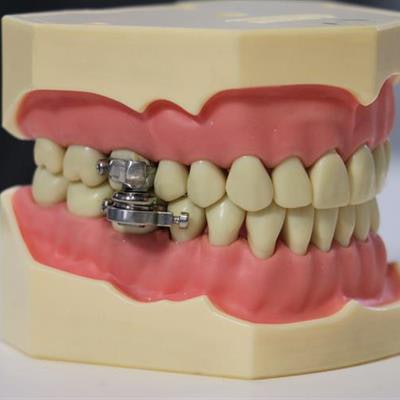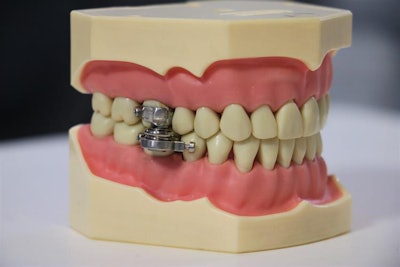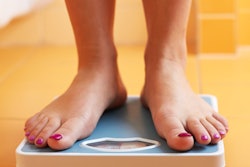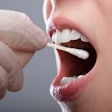
It sounds extreme, but it worked. International researchers found that an oral device that locks the jaws to allow the ingestion of only liquids led to an average weight loss of 14 lb in the brave individuals who tested it.
Though the weight loss was quick, DentalSlim Diet Control was not built for long-term wear. It was designed for those who hope to kickstart their weight loss journey and to get patients to lose a few pounds before they must undergo general anesthesia, according to a statement issued on June 28 by the University of Otago in New Zealand. Results of the clinical trial were published on June 25 in the British Dental Journal.
"The participants tolerated the device for a two-week period with satisfactory weight loss and were further motivated to continue their weight loss journey," wrote the BDJ authors, led by Dr. Paul Brunton from the University of Otago.
 The DentalSlim Diet Control weight-loss device. Image courtesy of the University of Otago.
The DentalSlim Diet Control weight-loss device. Image courtesy of the University of Otago.Packing on the pounds
Obesity has increased at an alarming rate globally, with about one-third of the world's population classified as overweight or obese. By 2030, an estimated 57% of the world's adult population will be overweight or obese.
Though calorie restriction and a regular exercise routine are key to weight loss, the effects are often negligible or short term because people abandon their lifestyle changes. Others turn to prescription medication, which may yield moderate-term results but carries side effects and can be expensive. Bariatric surgery has become the most popular option because it offers superior outcomes, but it is invasive, expensive, and not appropriate for all patients.
Then there is maxillomandibular fixation. In the 1980s, dentists and physicians surgically wired people's jaws shut as a weight loss aid, restricting patients to a liquid diet. After six months, patients lost 44 lb to 66 lb, according to previously published research.
Despite the weight loss, the procedure came with the risk of vomiting and choking, and patients developed periodontal disease after nine to 12 months. Some patients developed anxiety and psychiatric conditions, and when the wire was removed, some were left with restricted jaw movement.
Because most weight-loss options have risks and other negative factors, the researchers in the current study sought alternatives and developed DentalSlim Diet Control. The device consists of closed-field magnets with custom-manufactured locking bolts and orthodontic bands that affix to a patient's first molars. DentalSlim Diet Control restricts an individual's mouth opening to about 2 mm, restricting him or her to a liquid diet.
The researchers evaluated the device in six healthy women with a body mass index greater than 30. A dentist used cement to attach DentalSlim Diet Control, and the subjects were instructed to drink 1,200 calories per day of a commercially available liquid diet for two weeks. They were also instructed to maintain their oral hygiene and were given a mouthwash to use. In case of an emergency, such as choking or a panic attack, the participants and others of their choosing were taught how to disengage the device. They were told to keep the device's emergency release tool with them, according to the authors.
To assess the device's comfort and tolerability, the women completed a quality-of-life survey at appointments on days 1, 7, and 14, as well as two weeks after device removal.
Pounds lost
On average, the participants lost about 5% of their body weight. Mean weight loss was 6.36 kg (14 lb), with a standard deviation of 3.79 kg (8.4 lb), the authors wrote.
Additionally, the participants found the device "tolerable" and were pleased with the weight loss. However, some experienced mild trouble speaking and felt their lives were less satisfying when wearing the device.
Participant comments included statements such as "Started a healthy diet and started working out" and "motivated to continue to lose weight" after they had shed some pounds and the device was removed. Finally, none of the women needed to use the emergency release device, Brunton and colleagues noted.
Nonetheless, the trial had limitations, including its small sample size and the short device-wearing period of two weeks, they wrote.
Short-term tool, possible long-term effects
Unlike weight loss surgery or jaw wiring, DentalSlim Diet Control has several benefits. It can be worn a few weeks at a time and then removed to prevent potential adverse dental events, and the break allows for patients to have oral hygiene appointments. Also, it can be fitted by a dentist in about 20 minutes, the authors wrote.
Though future studies need to investigate the effect of episodic wear on the periodontal support for the anchor teeth, the trial results show that "weight loss can be obtained progressively with episodic applications interspersed with rest periods," Brunton and colleagues wrote.




















